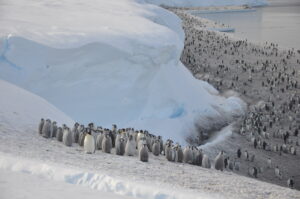 A new satellite study has revealed that emperor penguin numbers in Antarctica are dropping much faster than previously feared, sparking fresh concerns about the species’ survival as climate change worsens.
A new satellite study has revealed that emperor penguin numbers in Antarctica are dropping much faster than previously feared, sparking fresh concerns about the species’ survival as climate change worsens.
Researchers from the British Antarctic Survey, publishing their findings in Nature Communications: Earth & Environment, found a 22 per cent decline in emperor penguin numbers over the past 15 years across key regions the Antarctic Peninsula, Weddell Sea, and Bellingshausen Sea. This data covers nearly 30 per cent of the continent’s emperor penguin colonies, raising fears that the problem could be just as severe across the entire Antarctic region.
Dr Peter Fretwell, one of the lead scientists, warned that while there is some uncertainty in satellite-based wildlife counting, the sharp decline is worrying. “If this pattern holds for the whole continent, it’s far worse than the worst-case scenarios predicted for this century,” he said.
Tracking emperor penguins directly is dangerous in Antarctica’s harsh environment, so scientists rely on high-resolution satellite images to spot their black huddles against the ice. The estimated global population of emperor penguins ranges between 500,000 and 600,000 a small number compared to the human population of 8.2 billion.
Between 2009 and 2018, global emperor penguin numbers were already estimated to have declined by 9.5 per cent. But the latest data, covering up to 2024, shows the pace of decline may be accelerating, pushing the species closer to potential extinction within 75 years or even sooner.
The main threat remains climate change, especially the loss of stable sea ice caused by the burning of fossil fuels. Emperor penguins need these floating ice platforms to remain intact for at least eight months each year to breed and raise their chicks. A devastating example was recorded by satellites in 2022, when collapsing sea ice caused thousands of penguin chicks to drown.
Dr Phil Trathan, a co-author of the study, warned that only drastic cuts to global greenhouse gas emissions can prevent the species from becoming virtually extinct in the wild by the end of this century. “We’re seeing changes faster than even computer models predicted. There are likely other climate factors we still don’t fully understand,” he said.
If nothing changes, future generations may only be able to see emperor penguins in zoos, where they would exist solely for human display, without any chance of survival in the wild.
The findings serve as yet another stark reminder of the rapid impact of climate change on fragile ecosystems — and the urgent need for action to protect one of the world’s most iconic polar species.
